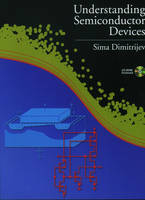
Understanding Semiconductor Devices
Oxford University Press Inc (Verlag)
978-0-19-513186-4 (ISBN)
- Titel ist leider vergriffen;
keine Neuauflage - Artikel merken
Understanding semiconductor devices, as the building blocks of electronic circuits, is clearly of fundamental importance. In response to this challenge, this text, suitable for an advanced undergraduate or early graduate level course, is written to achieve the following goals: 1.)To meet the students' need to understand with: a)intuitive explanations of the underlying scientific concepts, b)explained fundamental equations, as opposed to using mathematics to explain physical phenomena, c)explained energy-band diagrams to provide rigorous and powerful presentations, which are easy to understand through an analogy with balls on a solid surface and bubbles in water, d)intriguing review questions, and a comprehensive set of worked out examples and problems. 2.)To provide a vertical (electronics-to-physics) hierarchy and a lateral (in terms of contents) flexibility. The electronics-to-physics approach motivates the students to learn the underlying scientific concepts and mathematical models by providing appropriate context and a continuous progression from the common-sense towards more abstract concepts. 3.)
To provide CAD "nuts and bolts" with a small SPICE simulator widely used for computer-aided design of electronic circuits. The SPICE contents of this book provide a unique reference and pedagogical tools including: a)tabular presentations of the equations used as device models, b)hierarchically classified and explained SPICE parameters, c)case by case description of parameter measurement techniques, d)computer-based exercises that illustrate the effects of individual SPICE parameters on device and circuits characteristics. 4.)To provide links between the theoretical principles and real-life issues. The following points illustrate the level of integration achieved in this book: a)The device descriptions develop from application concepts (basic circuits). The underlying scientific concepts are "discovered" as needed. The introductions of particular device effects are explained by directly linked descriptions of what is happening on an atomic scale, b)Direct links are established between the fundamental equations and pragmatic SPICE models, c)Practically important issues such as reliability, device parameter measurements, etc., are presented such that they are directly related to the descriptions of fundamental device electronics and technology.
Part 1 Resistors: introduction to semiconductors; the basics - resistor structure and drift current; insight into conducitivity ingredients - chemical-bond model; making a semiconductor resistor - lithography and diffusion; carrier mobility; energy-band model; capacitors - reverse-biased P-N junction and MOS structure. Part 2 Basic applications: reverse-biased P-N junction; $C$--$V$ dependence of the reverse-biased P-N junction - solving the Poisson equation; SPICE parameters and their measurement; metal-oxide-semiconductor (MOS) capacitor and thermal oxide. Part 3 Diodes: forward-biased P-N junction and metal-semiconductor contact; rectifying diodes - fundamental effects and models; SPICE models and parameters, stored charge capacitance, and temperature effects; reference diodes - breakdown phenomena; Schottky diodes - metal-semiconductor contact. Part 4 Basics of transistor applications: analog circuits; digital circuits. Part 5 MOSFET: MOSFET principles; MOSFET technologies; MOSFET modelling; SPICE parameters and parasitic elements. Part 6 BJT: BJT principles; bipolar IC technologies; BJT modelling; SPICE parameters; parasitic elements not included in device models. Part 7 advanced and specific IC devices and technologies: deep sub-micron MOSFET; memory devices; silicon-on-insulator (SOI) technology; BICMOS technolgoy. Part 8 Photographic devices: light emitting diodes (LED) - carrier recombination; photodetectors and solar cells - external carrier generation; lasers. Part 9 Microwave FETs and diodes: gallium-arsenide versus silicon; JFET; MESFET; HEMT; negative resistance diodes. Part 10 Power devices: power devices in switch-mode power circuits; power diodes; power MOSFET; IGBT; thyristor. Part 11 Semiconductor device reliability; basic reliability concepts; failure mechanisms; reliability screening; reliability measurement. Part 12 Quantum mechanics: wave function; Heisenberg uncertainty principle; Schrodinger equation. Appendixes: basic integrated circuit concepts and economics; crystal lattices, planes, and directions; Hall effect and summary of kinetic phenomena; summary of equations and key points; list of Selected symbols; answers to selected problems.
| Zusatzinfo | numerous line illustrations |
|---|---|
| Verlagsort | New York |
| Sprache | englisch |
| Gewicht | 1176 g |
| Themenwelt | Technik ► Elektrotechnik / Energietechnik |
| ISBN-10 | 0-19-513186-X / 019513186X |
| ISBN-13 | 978-0-19-513186-4 / 9780195131864 |
| Zustand | Neuware |
| Haben Sie eine Frage zum Produkt? |
aus dem Bereich


